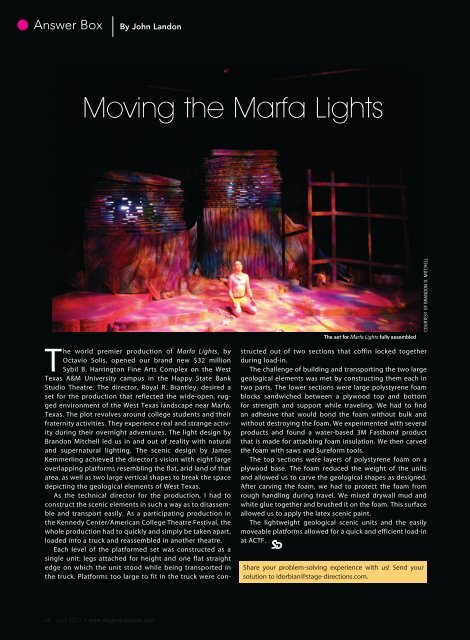Download a PDF - Stage Directions Magazine
Download a PDF - Stage Directions Magazine
Download a PDF - Stage Directions Magazine
You also want an ePaper? Increase the reach of your titles
YUMPU automatically turns print PDFs into web optimized ePapers that Google loves.
Answer Box<br />
By John Landon<br />
Moving the Marfa Lights<br />
Marfa Lights necessitate the moving of worlds<br />
The set for Marfa Lights fully assembled<br />
COURTESY OF BRANDON D. MITCHELL<br />
The world premier production of Marfa Lights, by<br />
Octavio Solis, opened our brand new $32 million<br />
Sybil B. Harrington Fine Arts Complex on the West<br />
Texas A&M University campus in the Happy State Bank<br />
Studio Theatre. The director, Royal R. Brantley, desired a<br />
set for the production that reflected the wide-open, rugged<br />
environment of the West Texas landscape near Marfa,<br />
Texas. The plot revolves around college students and their<br />
fraternity activities. They experience real and strange activity<br />
during their overnight adventures. The light design by<br />
Brandon Mitchell led us in and out of reality with natural<br />
and supernatural lighting. The scenic design by James<br />
Kemmerling achieved the director’s vision with eight large<br />
overlapping platforms resembling the flat, arid land of that<br />
area, as well as two large vertical shapes to break the space<br />
depicting the geological elements of West Texas.<br />
As the technical director for the production, I had to<br />
construct the scenic elements in such a way as to disassemble<br />
and transport easily. As a participating production in<br />
the Kennedy Center/American College Theatre Festival, the<br />
whole production had to quickly and simply be taken apart,<br />
loaded into a truck and reassembled in another theatre.<br />
Each level of the platformed set was constructed as a<br />
single unit: legs attached for height and one flat straight<br />
edge on which the unit stood while being transported in<br />
the truck. Platforms too large to fit in the truck were constructed<br />
out of two sections that coffin locked together<br />
during load-in.<br />
The challenge of building and transporting the two large<br />
geological elements was met by constructing them each in<br />
two parts. The lower sections were large polystyrene foam<br />
blocks sandwiched between a plywood top and bottom<br />
for strength and support while traveling. We had to find<br />
an adhesive that would bond the foam without bulk and<br />
without destroying the foam. We experimented with several<br />
products and found a water-based 3M Fastbond product<br />
that is made for attaching foam insulation. We then carved<br />
the foam with saws and Sureform tools.<br />
The top sections were layers of polystyrene foam on a<br />
plywood base. The foam reduced the weight of the units<br />
and allowed us to carve the geological shapes as designed.<br />
After carving the foam, we had to protect the foam from<br />
rough handling during travel. We mixed drywall mud and<br />
white glue together and brushed it on the foam. This surface<br />
allowed us to apply the latex scenic paint.<br />
The lightweight geological scenic units and the easily<br />
moveable platforms allowed for a quick and efficient load-in<br />
at ACTF.<br />
Share your problem-solving experience with us! Send your<br />
solution to idorbian@stage-directions.com.<br />
48 April 2007 • www.stage-directions.com

















